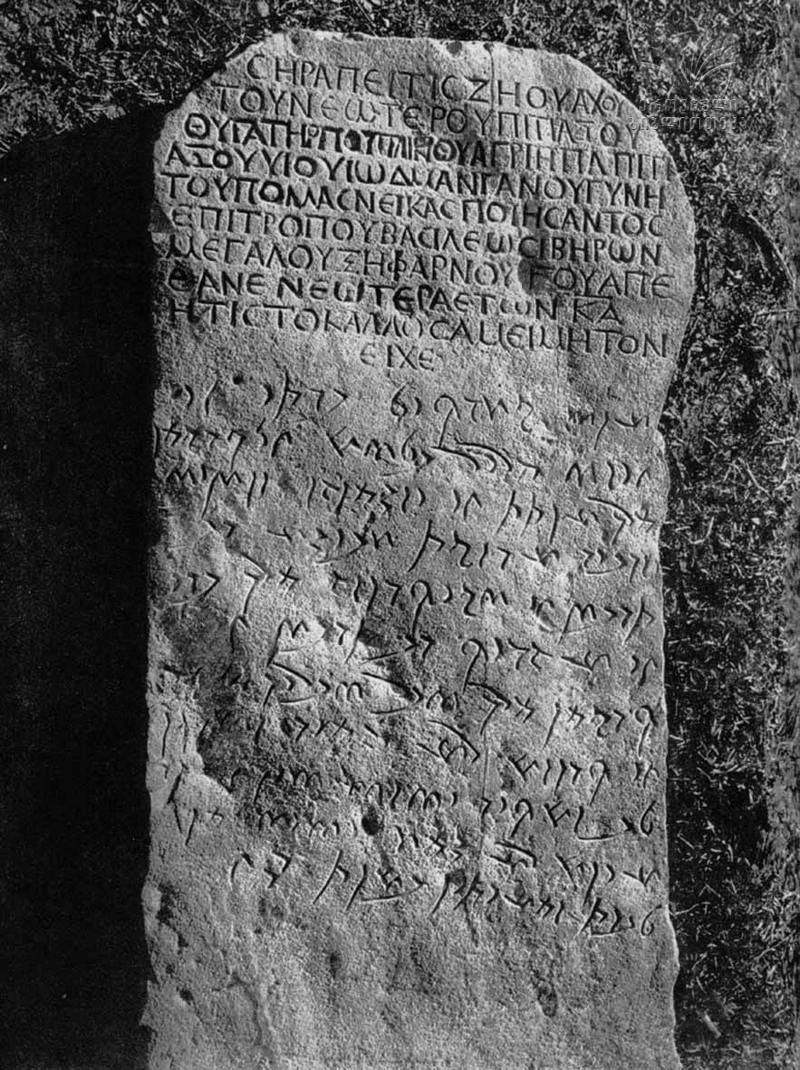Bilingual Inscription of Armazi

Bilingual Inscription of Armazi
The Stele of Serapeitis (also known as the Bilingual Inscription from Armazi), is a bilingual inscription discovered in Armazi, during archeological excavations in Mtskheta (1940). It is an epitaph inscribed on a stone stele in Greek and Aramaic languages. The Inscription dates back to the 2nd century AD. The Greek portion contains 9 stanzas; S. Kaukhchishvili and A. Shanidze deciphered and published their findings in 1941. In 1941-42, G. Tsereteli deciphered the Aramaic part containing 11 stanzas and published a relevant study called Bilingual Inscription from Armazi in Georgian, Russian, and English. For the most part, both inscriptions are nearly identical, however, the Aramaic part is much longer and contains more information about the deceased and her spouse. According to the Greek text, Serapeitis (the addressee of the epitaph) was the daughter of Zevakh Pitiakhsh and wife of Iodmanganos, master of the court of great Iberian King Xepharnougos and son of Publicius Agrippa, Pitiacksh. This inscription mentions that she (Serapeitis) had exceptional beauty and died at the age of 21. Aramaic text additionally mentions King Pharasmanes (two times) as the patron of Zevakh Pitiakhsh, and in connection with his duties, the name of King Pharnavaz might be mentioned as well (G. Tsereteli). In the Aramaic part, there are additional epithets for Serapeitis (Kind, Fair – in the second part of the epitaph). Another difference in Greek and Aramaic texts of the epitaph grabs our attention. The Greek inscription is in the third person, while Aramaic is in the first. However, in second half of the Aramaic text, which starts after “and thus”, continues in the third person. Together with the Stele of Serapeitis archeologists found Monolingual Inscription from Armazi. These two discoveries are important for Georgia, its cultural history, and the Middle East studies as well. The inscriptions describe the Iberian state structure of that time (1st-2nd centuries), and mention high-ranking historical figures (King, Pitiakhsh, master of the court) that were previously unknown.
After studying the Aramaic part of the Stele of Serapeitis, a new kind of Aramaic script was discovered, which today is referred to as the Armazic language (G. Tsereteli). The Stele of Serapeitis sparked great interest and caused discourse among specialists, primarily the language of the text. They could not decide whether an inscription that used Aramaic letters was written in the Armazic language, one of the Iranian languages (Parthian, Pahlavi), or Georgian (as we know, Iranians used words written in Aramaic language as ideograms for their own language). G. Tsereteli, who dedicated special research to this text, assumed that it was written in Aramaic, however, provided examples in support of the text being in Iranian. After the publication of the abovementioned research, many papers were written about the Stele of Serapeitis, and many corrections have been made in the interpretation and reading of the text. There should not be any doubt that this inscription is written in Aramaic language which continues the tradition of the “State Aramaic” language. Proper nouns are mostly of Iranian origin.
Bilingual Inscription from Armazi confirmed that in the 1st century AD, the Aramaic language was used alongside Greek in official circles in Iberia (such phenomena was common in other states of that time, e.g., Parthia). Furthermore, putting Greek inscription in the first position indicates the prestigious status of the language on an international scale in the Greek-Hellenistic period. On the other hand, the Aramaic language was more “commonly” used. This can explain why the Greek part of the epitaph only conveys the main subject i.e. identity of the deceased, while the Aramaic inscription gives additional information that is more relevant for the local population.
The Stele of Serapeitis became an impetus for deciphering other Aramaic inscriptions discovered in Georgia.
Literature: აბაევი ვ., არმაზის ბილინგვის გარშემო, «საქ. სსრ მეცნ. აკად. მოამბე», 1944, ტ. 5, № 8; გიორგაძე გ., არმაზის ბილინგვა: „ფარნავაზი“ თუ „ფარნავაზიანი“?, «მნათობი», 1986, № 10; ყაუხჩიშვილი ს., არმაზში აღმოჩენილი ბერძნული წარწერები, «საქ. სსრ მეცნ. აკად. მოამბე», 1941, ტ. 2, № 1–2; წერეთელი გ., არმაზის ბილინგვა, «ენიმკის მოამბე», 1942, ტ. 13; წერეთელი კ., შენიშვნები არმაზის ბილინგვის არამეულ ტექსტზე, თბ., 1992; Боголюбов М. Н., Армазская эпитафия, კრ.: Ирано-афразийские языковые контакты, М., 1987; Фрейман А. А., Несколько замечаний к «Армазской билингве» Церетели, Г. В.«Известия АН СССР». Отдел литературы и языка, 1946, т. 5, в. 2; Шанидзе А. Г., Данные греческо-пехлевийской билингвы из Армази для истории термина ეზოჲსმოძღუარი в древнегрузинском, «საქ. სსრ მეცნ. აკად. მოამბე», 1941, ტ. 2, № 1 – 2; Kutscher J., Naveh J., Bilingual inscription (Greec-Aramaic) from Armazi, «Lashonenu», 1970, vol. 34 (in Hebrew).
K. Tsereteli


